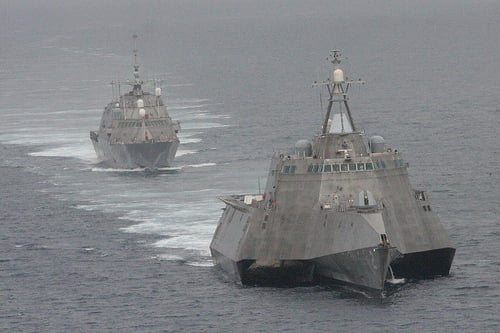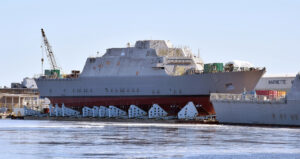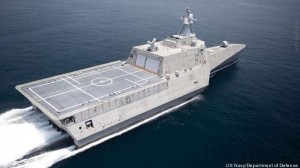
The two variants of the Navy Littoral Combat Ship — LCS-1 Freedom and LCS-2 Independence – side by side off the California coast.
WASHINGTON: Even as the Navy solicits designs for its future frigate, it is ardently defending its current Littoral Combat Ship. A memo obtained by Breaking Defense lists about three dozen pro-LCS attributes, followed by a mention of the frigate. Upgraded Littoral Combat Ships, of course, are the underdog contenders for the frigate.

France’s first two FREMM frigates, the Aquitaine and the Normandy, built by Italy’s Fincantieri, are a potential model for a future US frigate.
“This is an attempt by Naval Sea Systems Command (NAVSEA) to put LCS and the frigate on the same page together and begin the narrative that LCS should be picked as the new frigate, the FFG(X),” said Jerry Hendrix, a retired Navy captain now with the Center for a New American Security.
Reading between the lines, Hendrix said, the talking points boil down to “LCS is great! They are coming in under the cost cap by a good margin, and we have 11 built and another 18 on the way — and, oh, by the way, we have a new FFG(X) class coming up behind these. We don’t know what it will be, but we have decided to go after fully mature designs…such as, oh, LCS.”
“I really hope,” Hendrix added, “that senior Navy civilian leadership looks hard at affordable but larger and more robust foreign frigate designs that could be easily built in US shipyards.”
PEO LCS Talking Points 2017 Updated Nov 2017 – DISTRO A by BreakingDefense on Scribd
True, the wording of the section on the frigate is strictly neutral: “the Navy will consider any hull form – foreign and domestic – that meets the requirements and will be built at US shipyards.” It puts roughly equal weight on reducing cost, where the smaller LCS variants have the advantage over their larger rivals, as it does on increasing capabilities, where the bigger ships offer more. But the context of the memo — touting LCS at length before mentioning a program where LCS happens to be a competitor — is at very least suggestive.
https://www.youtube.com/watch?v=AGrvQ1c5khU&feature=youtu.be&t=11s
LCS Successes*
The bulk of the memo is a list of LCS successes. Equally notable is what it leaves out. True, the two very different LCS hulls — the Independence-class catamaran and the more conventional Freedom class — have worked out most of their new-ship bugs and are now in production at a high rate and relatively low cost, for warships. However, Congress has repeatedly hammered the program because the interchangeable “mission modules” that include most of LCS’s weapons, drones, and other combat equipment remain painfully behind schedule.

The LCS Coronado test-fires a new anti-ship missile from Norway’s Kongsberg.
Only the ship-to-ship combat module (Anti-Surface Warfare or ASUW) has officially reached Initial Operational Capability (IOC), and that’s without the long-range missiles originally envisioned. The Navy is looking for an Over-The-Horizon (OTH) anti-ship missile to install on LCS and possibly other lightly-armed vessels, but two of three competitors (Lockheed and Boeing) have dropped out, and the OTH effort is not mentioned in the memo. But a long-range anti-ship weapon is essential to the Navy’s concept for future combat, Distributed Lethality. Without one, LCS is irrelevant to a major naval battle with, say, China.
The equipment packages for LCS’s two other missions, Anti-Submarine Warfare (ASW) and Mine Counter-Measures (MCM), are about a decade behind schedule — a fact the memo doesn’t mention — although the Navy say it is making progress.
“The ASW capabilities being fielded are as good as the paper says,” retired Navy commander Bryan McGrath told me. “I’m bullish on the individual components of the ASW system that are derivative of the highly successful AN/SQR-89 (V) 15 system already in the fleet….The technical challenges here are manageable.” In other words, the Navy is taking sub-hunting technology already proven on other vessels and simply repacking it for LCS.
“As for the MCM module, I’m cautiously optimistic, shading toward cautious,” McGrath continued. “It is most important capability that will be fielded in the program, and it has had a series of regrettable false starts.” But the current incarnation of the mine-hunting mission package, like the ASW one, relies largely on technology already proven in other parts of the fleet. Fielding will begin in 2019, the memo says.

LCS-2, USS Independence, followed by LCS-1, USS Freedom, showing the two different designs.
The Case For LCS
Certainly, Congress has kept funding LCS — even adding ships to the Navy’s request. Certainly, many senior admirals strongly endorse it. Once the ships already in service, in production, and under contract are fully kitted out, they will play important supporting roles in hunting submarines, fending off fast-attack boats and sinking enemy warships. Eventually, when the aging Avenger mine warfare class is retired, the Littoral Combat Ships will also be the Navy’s only minesweepers. Official naval Force Structure Assessments consistently call for 52 “small surface combatants” to support a larger number of larger destroyers, and the vast majority of those small combatants will be LCS, whatever the future frigate becomes.

LCS-9, the future USS Little Rock, awaits launch.
No wonder, then, that admirals like Tom Rowden say things like: “I cannot wait to have (more LCS) in the fleet and cannot get them there fast enough.” (Now-Vice Adm. Rowden has been an LCS advocate since at least 2012).
“I am a huge fan of the LCS,” the memo quotes Fleet Forces commander Adm. Philip Davidson as saying. “Its modularity and tactical speed will do us well in the years ahead.” Of course, the modules aren’t done yet, and the tactical value of the LCS’s 45-plus-knot speed — and the expensive engines it requires — has been a debate since day one.
“When we really use LCS to its full potential, we use it like a ninja warrior,” said Rear Adm. Don Gabrielson, who runs international wargames and exercises for the Japan-based 7th Fleet. “It sneaks in from the shadows, it attacks from the shadows and then it disappears. It’s gone immediately or before anybody has a chance to locate it. It gets lost in the clutter of the islands so that it complicates anyone’s ability to attack it.” Again, that may be true in exercises, but it will only become true in reality when the LCS is fully equipped, specifically with an Over-The-Horizon anti-ship missile.

LCS-2, USS Independence
“The quotes (in the memo) suggest admirals are happy with the capacity LCS brings, which make sense since the Navy now has no ocean-going small combatants other than LCS, and precious few of those,” said Bryan Clark, a retired Navy commander now with the Center for Strategic & Budgetary assessments. (Cyclone-class patrol craft and Avenger-class minesweepers must hitch a ride across the ocean on a bigger ship). “LCS is now providing some capacity to sustain presence in the Western Pacific and will eventually help with new and useful ASW and MCM capabilities,” he said, “but recent experience with the Houthis indicates LCS would need to be defended, (because) the LCS’s small air defense capacity will make it vulnerable to missile attack from shore or ships.” That might require tying up an Aegis destroyer to watch over the smaller ships.
As Rear Adm. Gabrielson says, the Littoral Combat Ship has a lot of potential. The first open question is whether LCS will live up to that potential. The second is whether LCS is the best starting place for a future frigate design, or whether the Navy needs something new.
Sullivan: Defense industry ‘still underestimating’ global need for munitions
National Security Advisor Jake Sullivan said that there are “no plans” for another Ukraine supplemental at this point.


























